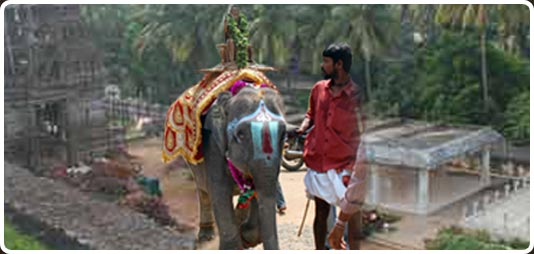The abode of Chittibaba and Babu is called Shri Sadguru Chittibabaji Samsthanam, an expanse of 180 cents of land which has a Samadhi Mandiram, the sanctum sanctorium of Chittibabaji connected to a Mandapam and a living quarters adjoined by a kitchen and a dining hall called the Nityannadanasatram.
Towards the east of the Samsthanam is an ongoing temple site meant to enshrine Chittibabaji along with 108 Stupas encased with the sacred name of Sri Rama, written in form of a book called Ramakoti. Retrospectively, each individual Stupa would be one Crore such Ramakoti books.
The Stupa would be divided into three tiers, the base would be ensconced with the Ramakoti, the middle-tier would be having a Basil plant, traditionally considered sacred and the top-tier would be having a perennial oil-lamp, known as Nanda Deepam. The summit of the Stupa has the sculpture of the Lord Panduranga along with a Bilva sapling. Each Stupa would be dedicated to a sacred cow. Each Stupa is also inscribed with 108 sacred names of Chittibaba, who like the Buddha has gone through a series of 107 lives each merited with a spiritual height attained by him and the final life in which he attained the form of a Sadguru. The sacred names are known as the Ashtotarasatanamavali. A part of the Abode is a 4 acre Goshala or Gokshetram, a home presently to 186 cows in a picturesque setting in the village of Pedakondepudi, 5 kilometres from the Samsthanam.
The Samsthanam is itself on the banks of the Godavari’s main course. The region in the early historic period was associated with three huge Buddhist monasteries Ramadurgam, Korukonda and Rampa Errampalem, all of which were interspersed with several votive Buddhist structures that have been excavated during the recent decades.
The entire bank of the lower course of the River Godavari has traditionally been associated with the Ramayana and the sacred name of Lord Rama. Interestingly, the Samsthanam is in a place called Sri Rama Nagaram which is flanked in its way initially by Munikudali (the abode of Sages) Raghudevapuram (the abode of the Raghu lineage to which Lord Rama belonged) Sri Rama Nagaram itself along with Sitanagaram and Lankuru (Lanka).
Tweet


